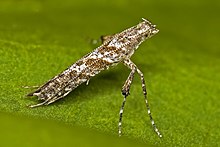| Gracillarioidea | |
|---|---|

| |
| Caloptilia cuculipennella (Hübner, 1796) | |
| Scientific classification | |
| Domain: | Eukaryota |
| Kingdom: | Animalia |
| Phylum: | Arthropoda |
| Class: | Insecta |
| Order: | Lepidoptera |
| Clade: | Ditrysia |
| Superfamily: | Gracillarioidea |
| Families | |
| Diversity | |
| Over 2300 species | |
Gracillarioidea is a large superfamily containing four families of insects in the order Lepidoptera. These generally small moths are miners in plant tissue as caterpillars. There are about 113 described genera distributed worldwide, the most commonly encountered of which are leaf miners in the family Gracillariidae.
References
[edit]- Davis, D.R, and Robinson, G.S. (1999). The Tineoidea and Gracillarioidea. In: Kristensen, N.P. (ed.), Lepidoptera, Moths and Butterflies, 1: Evolution, Systematics, and Biogeography. Handbuch der Zoologie 4 (35): 91-117. Walter de Gruyter. Berlin, New York.
External links
[edit]
Well, that’s interesting to know that Psilotum nudum are known as whisk ferns. Psilotum nudum is the commoner species of the two. While the P. flaccidum is a rare species and is found in the tropical islands. Both the species are usually epiphytic in habit and grow upon tree ferns. These species may also be terrestrial and grow in humus or in the crevices of the rocks.
View the detailed Guide of Psilotum nudum: Detailed Study Of Psilotum Nudum (Whisk Fern), Classification, Anatomy, Reproduction